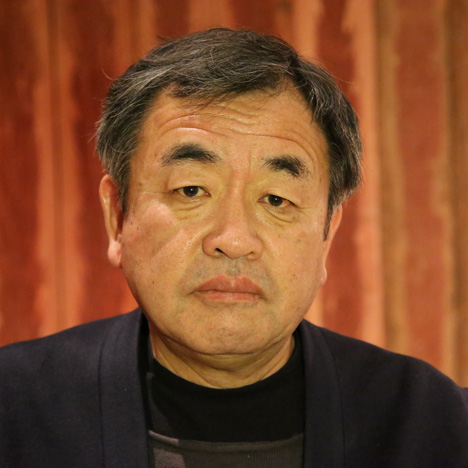
Kengo Kuma urges architects to "be humble"
Interview: on the anniversary of the Japanese tsunami of 2011, Japanese architect Kengo Kuma explains how the catastrophe made him rethink his attitude to architecture.
Speaking to Dezeen at London's Royal Academy of Arts where his work is on show as part of the high-profile Sensing Spaces exhibition, Kuma said architects must realise that their power is limited.
"The problem of twentieth century society was the arrogance of designers and engineers," he said. "Every architect and engineer thought that architecture was much stronger than nature. After the tsunami, we finally found that we were weak in front of the power of nature."
The destruction that followed the tsunami triggered by an undersea earthquake off the coast of Tōhoku three years ago made apparent the "extreme imbalance" of power between nature and buildings, said Kuma, leading him to "think that we couldn't use industrial materials anymore".
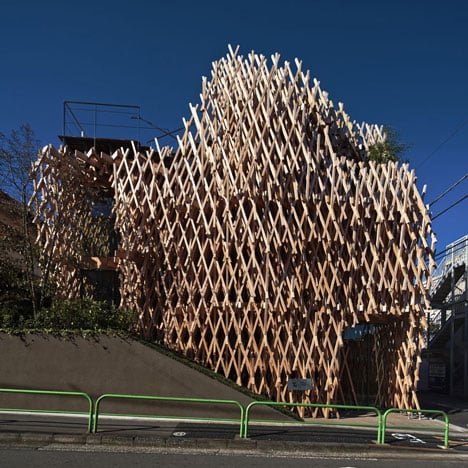
Many of his recent buildings, including The Sunny Hills cake shop in Tokyo, and the Besançon Art Centre and Cité de la Musique have made extensive use of timber.
"After the tsunami in March 2011, I changed my definition to nature," he told us. "The criteria for architecture after the tsunami is humbleness."
He feels this view is shared by several of his contemporaries. "After the tsunami, I think many architects think differently about architecture, especially in Japan," he said. Some architects are saying similar things for example, Toyo Ito. His designs were very contemporary before the tsunami, but after the tsunami, he's designed some wooden buildings: I feel a change in him."
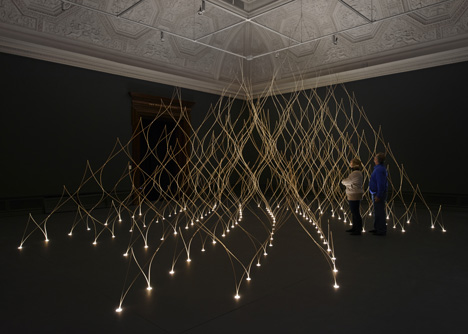
Kuma was at the Royal Academy of Arts to give a lecture on his Pavilion of Incense installation at the Sensing Spaces: Architecture Reimagined exhibition, in which seven practices were invited to build a series of large-scale installations.
Kuma's intervention uses a minimal bamboo structure, up-lit and impregnated with the smell of tatami mats and hinoki timber. Tatami mats are the woven mats commonly-used as traditional floor coverings in Japan and hinoki is a valuable timber prized for its smell.
The combination of a minimal structure and the strong smell would encourage visitors to focus on themselves and not the surrounding architecture, said Kuma.
"The idea for the pavilion at the Royal Academy came from the traditional Japanese teahouse," he said. "I decided to use bamboo because it is a natural material and at the same time, it is very strong: it’s like a carbon fibre. It can create a transparent space with the minimum volume of material. I wanted people to focus on the space itself."
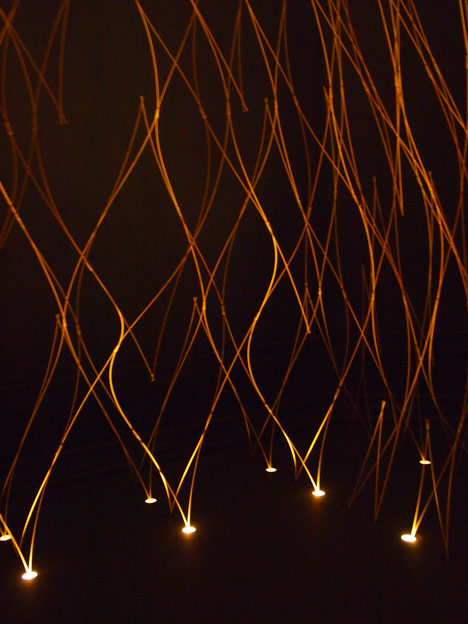
Kuma described how he wanted his pavilion to encourage people to reconnect with what he calls "the totality of architecture".
"People [now] find new architecture through media: through books, through drawings, only through visual images," he explained. "In the twenty-first century they forget the totality of experience. I want to recover that totality in architectural design."
"For me, the visual effect is only [a small] part of the design," he continued. "Totality of architectural design includes textures, the soft and hardness of the material, the smell of the material and the acoustic effect of the material."
For Kuma, the trick to attaining this totality is by working with materials very early in a project: "The secret to my design is that from the beginning of our design process, I'm thinking about what is the material for the building, what is the finish of the building."
"In the normal process of architecture, the decision of the material is often the last part of the design. I think that causes many mistakes. The decision for the material should come at the beginning of the design," he added.
Here's an edited transcript of the interview:
James Pallister: Tell me about your installation at the Sensing Spaces exhibition
Kengo Kuma: The initial idea for the pavilion at the Royal Academy came from the traditional Japanese teahouse. I decided to use bamboo because it is a natural material and at the same time, it is very strong: it's like a carbon fibre. It can create a transparent space with the minimum volume of material. I wanted people to focus on the space itself.
James Pallister: And that's something that's important for you: to create big volumes with minimal structure?
Kengo Kuma: Yes, that contrast is very necessary. Creating volumes with minimal structure is a theme of our practice. In every project we want to create that kind of "minimalness" by the use of very limited materials.
James Pallister: And why is that?
Kengo Kuma: In the twentieth century volume in itself had meaning: now I want to minimise volume.
James Pallister: Can you tell me about the smells used in the pavilions at the Royal Academy?
Kengo Kuma: For the pavilions I chose two types of smell. One is the smell of hinoki timber and the other is the smell of tatami mats. Both are very much related with my personal memory; the house I grew up in was built before the Second World War. It's a very, very old house with these two smells: the timber smell and tatami mat smell. Those smells and the atmosphere of that house are very much related.
The Japanese tradition has not been a history of visual design, but it is [closely linked] to the history of smells and the tatami and hinoki smell are the two oldest smells of our tradition. Anybody can understand the beauty of those smells.
James Pallister: And can you just explain what a tatami mat is?
Kengo Kuma: A tatami mat is a typical material finish for the floor. We Japanese used to sleep on that tatami mat and that special smell can give the special kind of quietness, the feeling of healing.
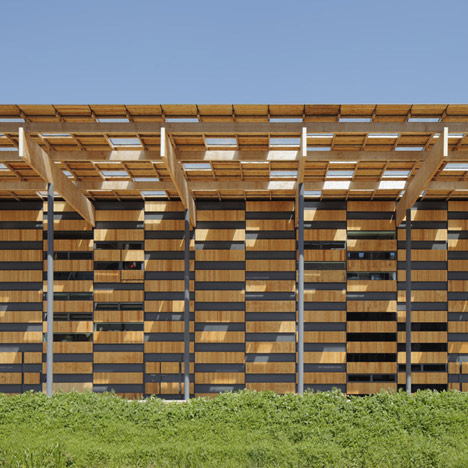
James Pallister: What were you trying to achieve in the pavilion?
Kengo Kuma: I wanted to create darkness. If my pavilion had a strong shape, then that shape overpowers the other senses of the people. Darkness is important, minimalness is important, transparency is important for the design. I want to create that kind of nothing, that kind of void through the material. In Zen philosophy, people use minimal material to think about deeper space. That message gave me many hints for the design. The pavilion at the Royal Academy is the pavilion of nothing. The nothing is not really nothing; I wanted to show the richness of nothing through the pavilion.
James Pallister: What do you hope people will come away with, having visited the pavilion? What kind of feeling? Is it about contemplation, finding peace of mind?
Kengo Kuma: I want people who visit the pavilion to concentrate on themselves: not necessarily to think about the design, just to concentrate to themselves.
James Pallister: How important is ritual to your architecture?
Kengo Kuma: For me, the visual effect is only [a small] part of the design. The smell, the textures, the effect of light and the acoustics can create the kind of experience that is totality.
James Pallister: And do you think twenty-first century architects sometimes forget the importance of those more sensual experiences?
Kengo Kuma: In terms of sensuality, people [now] find new architecture through media: through books, through drawings, only through the visual images. In the twenty-first century they forgot that totality of experience. I want to recover that totality in architectural design.
James Pallister: And what is that totality?
Kengo Kuma: Totality of architectural design includes textures, the soft and hardness of the material, the smell of the material and the acoustic effect of the material. That kind of totality of everything.
James Pallister: How does your practice try and achieve that?
Kengo Kuma: We always bring the material ourselves to the studio. Of course we use computers for design, but we always have the material itself in the studio. The conversation about the material can give many hints to our design.
James Pallister: So it's important to have that physical material with you when you are designing?
Kengo Kuma: The secret to my design is that from the beginning of our design process, I'm thinking about what is the material for the building, what is the finish of the building. In the normal process of architecture, the decision of the material is often the last part of the design. I think that causes many mistakes. The decision for the material should come at the beginning of the design.
James Pallister: You've said that architecture needs to get back to "smaller works". How important was the tsunami of 2011 in making you reconsider what architecture should do?
Kengo Kuma: After the burst of the bubble economy in the 1980s, I began to think differently from before. After the tsunami in March 2011, I changed my definition to nature. Before tsunami, I thought that nature was important but after the tsunami, I began to really think that nature is not so weak. The strength of nature compared to building is an extreme imbalance- that was my response to March 2011.
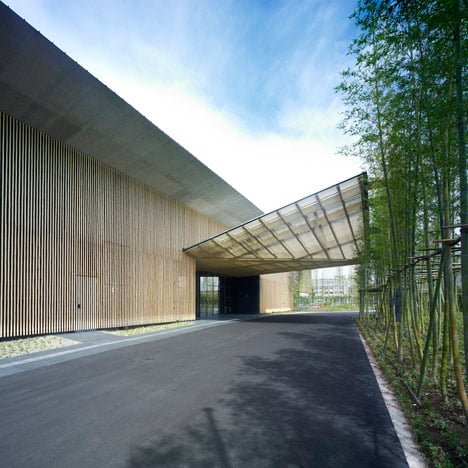
James Pallister: How does architecture respond to that?
Kengo Kuma: After the tsunami, I began to think that we couldn't use industrial materials anymore. This kind of shock came from the tsunami experience.
James Pallister: Do you think your view is shared by many?
Kengo Kuma: After the tsunami, I think many architects think differently about architecture, especially in Japan. Some architects are saying similar things for example, Toyo Ito, his designs were very contemporary before the tsunami, but after the tsunami, he's designed some wooden buildings: I feel a change in him.
James Pallister: Do you think this should happen in Europe as well?
Kengo Kuma: Probably the influence of the tsunami will extend very slowly and probably in the future, when there is a shock from tsunami, it can change our architecture anywhere in the world.
James Pallister: How will it change? Is it about architects having more humility?
Kengo Kuma: The influence of the tsunami can show the humbleness in front of nature. The humbleness can be a reflection on the selection of material, of the detail and the scale of the building. And the criteria for architecture after the tsunami is humbleness.
James Pallister: And are you hopeful for the future of architecture?
Kengo Kuma: I think so. That kind of disaster, like tsunami, is pointing out the problem of society. The problem of the twentieth century was the arrogance of designers and arrogance of engineers. Every architect and engineer thought that the architecture of good design was much stronger than the power of nature but after the tsunami, we finally found that we were so weak in front of the big power of nature.
James Pallister: You say that architects can be arrogant about their powers: do you think they should still try and make the world better?
Kengo Kuma: Yes. Tsunamis can lead us to a better place. The tsunami was a big lesson for us. I strongly feel for the student, that lesson is very important because sometimes for the young student for them, design is very, very powerful and that can dominate everything. But in front of the power of nature, they should probably change their understanding.
James Pallister: What's your advice to young architects?
Kengo Kuma: My advice to young architects is be humble. But don't give up hope.